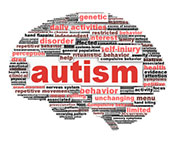
FRIDAY, Sept. 4, 2015 (HealthDay News) — The repetitive and restrictive behaviors common in autism aren’t seen as often in girls as they are in boys with the disorder, a new study says.
Researchers also found that there were differences in certain parts of the brain between girls and boys who exhibit these behaviors.
“Our findings suggest a potential factor that may contribute to the relatively low proportion of females with autism,” said the study’s lead author Kaustubh Supekar, a postdoctoral researcher at the Stanford University School of Medicine in California.
Supekar said repetitive and restrictive behaviors are one of the most noticeable characteristics in those with autism, and they are often the red flag that leads the child to be evaluated for the disorder. Examples include repetitive motions, a single-minded focus on a particular area of interest and strict adherence to routines.
“Our findings raise the possibility that girls with less prominent repetitive and restrictive behaviors may miss being tested for autism or get misclassified as social communication disorder,” Supekar said.
“On the other hand, boys with more pronounced repetitive and restrictive behaviors may show more false positives for autism spectrum disorders, given that repetitive and restricted behaviors are not specific to children with autism and are also observed in other neurodevelopmental disorders,” Supekar added.
The findings were published online Sept. 3 in the journal Molecular Autism.
The researchers conducted their study in two parts. First, they compared symptoms in 128 girls and 614 boys with autism. The children were between 7 and 13 years old, and all had a measured IQ over 70, the study authors said.
Next, the investigators looked through a publicly available database for MRI brain scan results for children with and without autism. This database also contained information on the children’s symptoms.
The researchers compared the MRI findings for 25 girls with autism, 25 boys with autism, 19 girls who developed typically and 19 typically developing boys, all with the same age and IQ range.
Both investigations showed that girls with autism tended to have less severe repetitive behaviors than the boys had. Social and communication difficulties were similar between both sexes, the findings showed.
In the MRI results, researchers saw differences in certain parts of the brain, including those related to movement, between boys and girls with autism. However, no differences were seen in girls and boys without autism.
The scientists also discovered differences in the gray matter in different parts of the brain between girls and boys among those with autism and more severe repetitive symptoms.
“Our findings indicate that the brains of girls with autism are structured differently from those of boys with autism, and that some of these differences are linked to sex differences in behavioral impairments that characterize autism,” Supekar said.
This discovery may have implications for differences in treatments for autism based on brain structure variations between the sexes, said Mayra Mendez, of Providence Saint John’s Child and Family Development Center in Santa Monica, Calif. Mendez is a program coordinator for intellectual and developmental disabilities and mental health services.
“Treatment for girls may best focus on building behavior skills that support social interactions and social communication as most important to remediate autism spectrum disorder behaviors in girls,” Mendez said.
“Targeting repetitive and restrictive behavior patterns by applying motor- and sensory-based strategies may generate positive behavioral change in boys presenting with high-functioning autism spectrum disorders,” she added.
But, not everyone agreed that the study’s results may have any implications for treatment, at least not yet, suggested Dr. Glen Elliott, chief psychiatrist and medical director of Children’s Health Council in Palo Alto, Calif.
“The sample size is small — 25 children in each group — and the finding is not especially dramatic,” Elliott said. “It is impossible to know how much these findings might apply to autism spectrum disorders more broadly. And the link between brain findings and behavioral observations may merely reflect correlation, not causation,” Elliott said.
“This is basic research that tells us something, hopefully, about brain function in individuals with autism, but it does not speak to treatment,” Elliott said. “Still, it is a wonderful example of the types of research that finally are enabling researchers to delve more deeply into what, exactly is different about the brain of an autistic individual.”
More information
For more about autism, visit the U.S. Centers for Disease Control and Prevention.
Copyright © 2025 HealthDay. All rights reserved.

